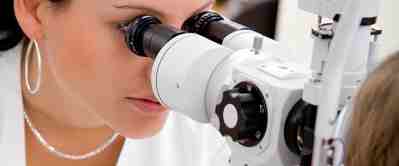

MedFriendly®


Ophthalmology
Ophthalmology is the science that deals with
structure, functions, and diseases of the eye,
and the diagnosis and treatment of such
diseases. This treatment is often done with
medication and/or surgery. Someone who
studies ophthalmology is known as an
ophthalmologist (compare to optometry and
optometrists). Ophthalmologists can perform
surgery on the eyes.
FEATURED BOOK: Basic Ophthalmology
Two common tools in the field of ophthalmology are phoropters and slit lamps. A
phoropter is an instrument that contains different lenses to measure the focusing of light
by the eye to determine the proper eyeglass prescription. A slit lamp is an instrument that
consists of a high-intensity light source that focuses a thin sheet (slit) of light on the eye
to help examine the frontal structures of the eye such as the lens, iris (colored part of the
eye), cornea (clear covering at the front of the eyeball), sclera (the white part of the eye),
eyelid, and the conjunctiva. The conjunctiva is a clear layer that covers and protects the
inside of the eyelids and the front part of the sclera.
You can read more about the field of ophthalmology by going to the American Academy of
Ophthalmology website. Ophthalmology comes from the Greek word "opthalmos" meaning
"eye," and the Greek word "logos" meaning "the study of." Put the two words together and
you have "the study of (the) eye."
"Where Medical Information is Easy to Understand"™















